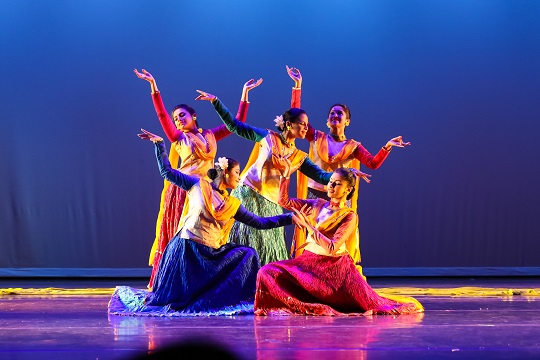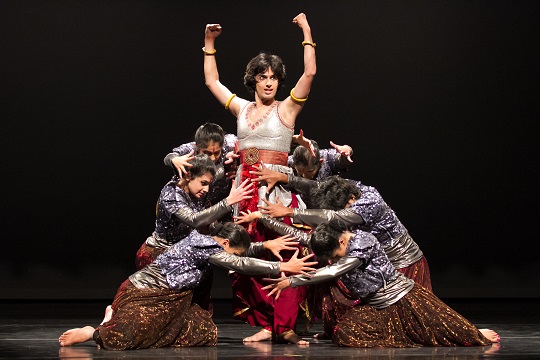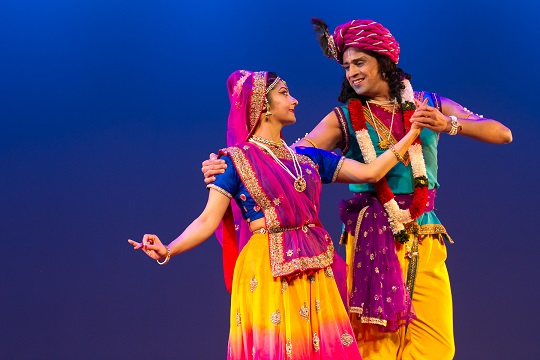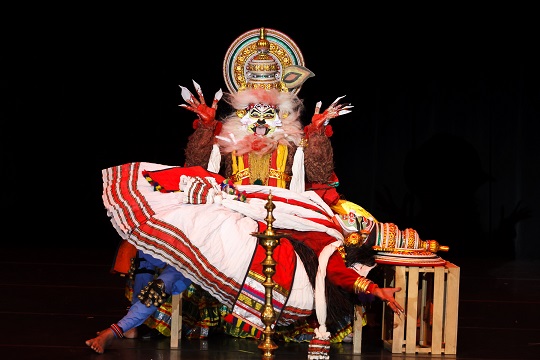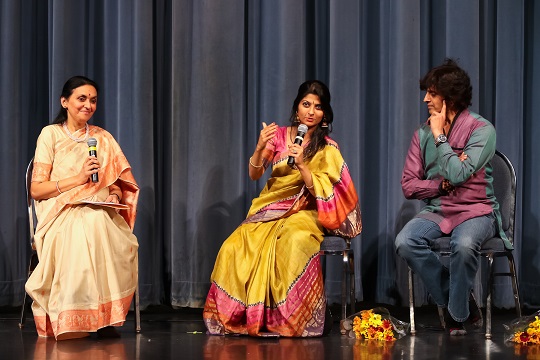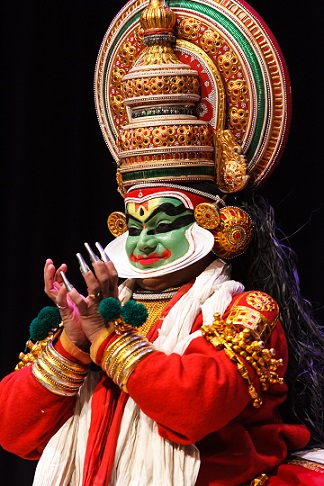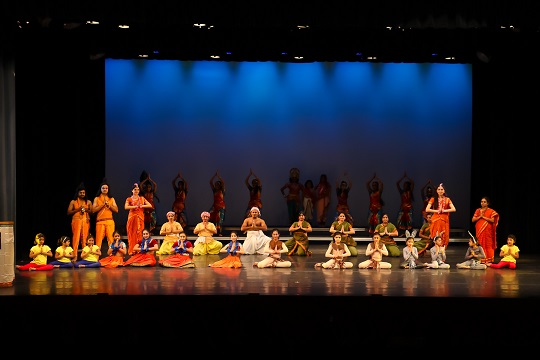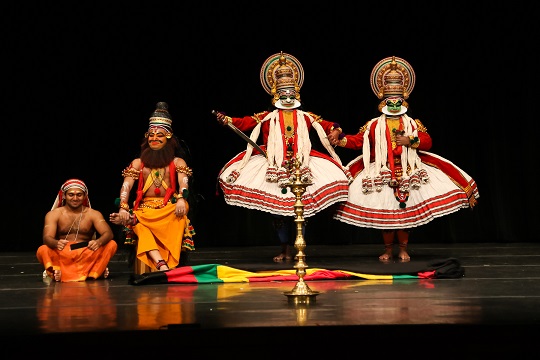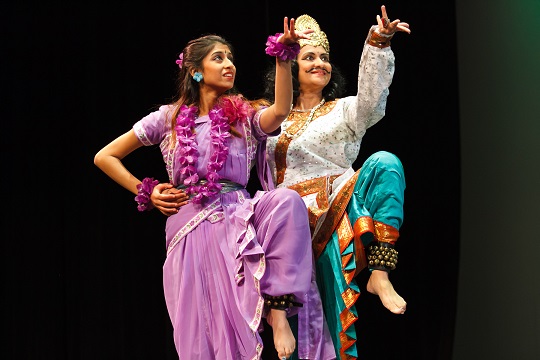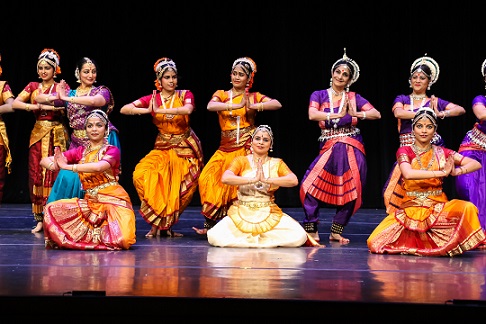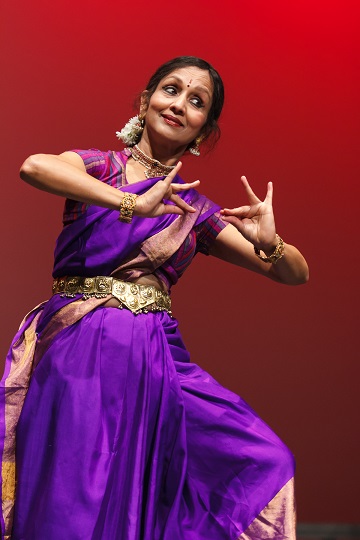Contribute
| Nrityotsav - A Festival Of Dance |
Chand Sripad
11/19/2014
Celebrating poetry of movement, Nrityotsav, a festival of dance, was brought to the Boston rasikas on November 8, 2014. The daylong festival showcased artistic pieces, aesthetic nuances, reflections on training and other elements of dancers’ journeys to performance. An idea conceived by Poornima Risbud and Pallavi Nagesha of Rasarang School of Performing Arts, Nrityotsav was further supported by Vanita and Shekhar Shastri of Meru Education Foundation, Neena Gulati of Triveni School of Dance, LearnQuest Academy of Music, and sponsored by eClinical Works and the Anuradha Palakurthi Foundation.
The day’s events opened with Pallavi Nagesha seeking the blessings of Lord Nataraja on behalf of all the dancers and offering to him dance in the spirit of surrender, “Tera Tujko Arpanâ€(to unto you what is yours). Vanita Shastri then invited the esteemed guest artists Kalamandalam Gopalakrishnan (Kathakali School of Dance, Kerala), Nirupama and T.D. Rajendra (Abhinava Dance company, Bengaluru, India ), to commence the Nrityotsav event by lighting the symbolic lamp invoking a collective luminous identity. Following the lighting of the lamp, Jothi Raghavan was invited to render the stage auspicious through her performance of the traditional Mallari, a symbolic of a procession of the deity to worship at a sacred place. Jothi is a doyen of Bharatanatyam in the Boston area (Nrithyanjali – Indian Academy of Performing Arts).
Having been declared sacred, the staged opened itself to the many feet that graced the day’s performances. First, it saw Kalidasa’s Abhignana Shakuntalam, a poetic dance drama that unfurled the beauty of nature, love, poignancy of Shakuntala’s plight, betrayal of King Dushyant, valor of Bharata, and finally unification of the family. Presented by Rasarang in collaboration with students of Nrityanjali School of Dance, Eastern Rhythms and Natya Vidyalaya, the dancers carried the tale expressively with elaborate costumes and stage settings.
A breakout session then followed, and the audience was treated to a lively informal fireside chat with Nirupama and Rajendra of Abhinava Dance Company in conversation with Vanita Shastri. The artists shared their backgrounds, training in dance, and coming together as two entities with a single soul through their pursuit of this joyous art. They spoke of their creative approach to choreography combining authentic forms in modern contexts; carrying the thread that seamlessly binds the dynamic concepts in their presentations. Their research in choreography involving the ‘Karnas’ from Natyashastra was exceptionally insightful with a beautiful demonstration including a voice segment by Nirupama. The exchange included participation from the audience, resulting in a refreshing dialogue.
Another highlight of the day (paralleling a lunch buffet) was a walking tour through the green room to experience the magic of Kathakali make-up by a make-up artist or the Chuttikaran. Visitors to the room were awed by the elaborate intrinsic detail of make-up, costumes and jewelry used by the Kathakali dancers of Kerala. It also provided an opportunity for folks to experience and appreciate the effort and complexity of tasks required in preparing for such a performance.
The afternoon’s segment, ‘Shree Varnam’ true to its name, was a vernacular of dance styles, presented by local dancers and students. Introduced to the audience by Mouli Pal, (Upasana), the dances formed a kaleidoscopic hue of Odissi, Bharatanatyam, and Kuchupudi. Odissi dance characterized by its sculptural poses and lyrical beauty was performed by Neena Gulati, Shamoyita Mukherjee and Jayashree Mohapatra. In Manikya veena, they sought the blessings of Goddess Saraswati, as they described her beautiful form playing the veena. In ‘Durga Stuti’, they extolled the virtues of Goddess Shakti or Durga as Kali and Mahishasura mardhini. In the Bharatanatyam style, a Meera bhajan ‘Hari Tuma haro’ was presented by Sapna Krishnan and students from Lasya School of Dance. Creatively choreographed, the dance related stories of Prahlada’s devotion, liberation of Gajendra, and protection of Draupadi’s chastity by Lord Vishnu. The performance combined expressive dance with rhythmic footwork. In the Kuchipudi style, ‘Marakatha Manimaya Cheyla’, a composition of Oothukadu Venkakata Subbha Iyer, was presented by Sailaja Chaudhary Tummala and dancers from Sri Kuchipudi Natyalaya. Kuchipudi, is especially known for its mime of the song, with alluring expressions, swift glances and facial movements. The dancers concluded with a skillful performance on the rim of a brass plate depicting Narthana Krishna to varied rhythms. Next, Jeyanthi Ghatraju, Mari Shakthi Muthuswamy and Marichandra Murugan artistically presented a Bharatanatyam segment on Bharatiyar’s poetic vision, ‘Pudhumai Penn’, in which dancers vividly described a woman as bold yet kind, educated and service minded, drawing parallels to women of modern times. The Thillana, in raga Hindolam created a joyous mood though the dancers’ agile movements to a brisk and lively rhythm. All dancers came together to present ‘Moksha’, liberating the dancer seeking unification with the supreme.
Dance teachers and performers, Ranjani Saigal (Eastern Rhythms) and Meena Subramanyam (Natya Vidyalaya), introduced the highly anticipated first Kathakali performance in the Boston area, welcomed Kalamandalam Gopalakrishnan and the artists’ ensemble from Kathakali School of Dance, Kerala, India. A short demonstration by Kalamamdalam Aravind, in an informal question answer format with Vanita Shastri and Revathy Pillai as interpreter, highlighted unique aspects of the dance form such as the use of the special curtain ‘Thirassheela’, accentuated hand gestures, and the art of character-specific make-up in presenting a dance drama. Green facial makeup is said to denote ‘good’ characters, like Rama, and the use of black make up indicates ‘evil’. The green highlighted with some red on the cheek, indicates a character with both ‘good’ and ‘evil’ like Ravana.
Prahlada Charitam, a dance theater performance in the Kathakali form, began with recorded traditional musical accompaniment (chenda, maddalam, chengila ilathalom and vocal) and the ‘Thirassheela’ drawn. The story of the demon king, who hated Lord Vishnu, opened before the eyes of the Boston audience in a whole new experience. The dancing accompanied with voice expression and elaborate hand gestures unraveled the story. As Prahlada prayed to Lord Vishnu to be his savior and appear from a pillar, all of a sudden the hall reverberated with the roar of a lion and entered in a aisle through the audience, a form half lion and half human – Vishnu in his Narasimha Avatara! The mesmerized audience watched as he ascended the stage, seized Hiranyakashipu, put him across his lap and tore at his entrails, then rose to bless his ardent devotee Prahlada. The elaborate costumes, make-up -especially that of Narasimha- and intense theatrical depiction had the audience rising to their feet for a standing ovation.
Poornima and Pallavi’s dream of a daylong festival of dance neared its finale as Ranjani Saigal and Meena Subramanyam introduced ‘Kathakitathom’ - a presentation of Abhinava Dance Company from Bengaluru, India. The dance team led by Nirupama and Rajendra wove their magic upon the Boston audience. From ‘Aavnee’, choreographed to unravel nature’s marvels, to ‘Kathakitathom’, their finale, it was a scintillating performance pulsating with joy and rhythm, combining creative choreography, intricacy of movement, lightness of step and subtlety of expression. Highlighting and encompassing aspects of dance forms mainly Kathak and Bharatanatyam, each presentation was enchantingly introduced by Nirupama. ‘Raas Leela’ transported one to the vivid colors of Brindavan capturing the essence of Raas; the Bravest of warriors Abhimanyu who lives on; Shakuntala’s beauty as beholden by a bee; and ‘Ta dha’ a coming together of two dancers Nirupama and Rajendra. ‘Prashna Uttar’ - a dialogue segment with Nirupama and Rajendra presenting jugal bandi of footwork in Kathak style preceded the dynamic rhythm of the concluding dance number Kathakitathom. The music and the mood had audience rise to the beat, clap their hands in taal (Rhythm) and give them a standing ovation.
As Nrityotsav drew to n close, Poornima and Pallavi expressed their heartfelt gratitude to Shiva, the Lord of Dance, for whom it was an offering. They thanked all the artists for coming together to perform, and countless supporters, volunteers who worked behind the scenes to make it happen and extended their gratefulness to the audience. The events were well orchestrated and ran smoothly all through the day. The experience of Nrityotsav allowed for each and every one of us to learn experience, share and grow in our love for Indian dance.
You may also access this article through our web-site http://www.lokvani.com/
